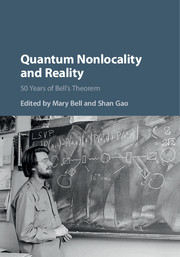Book contents
- Frontmatter
- Contents
- Contributors
- Preface
- Preface
- Part I John Stewart Bell: The Physicist
- Part II Bell's Theorem
- Part III Nonlocality: Illusion or Reality?
- 9 Strengthening Bell's Theorem: Removing the Hidden-Variable Assumption
- 10 Is Any Theory Compatible with the Quantum Predictions Necessarily Nonlocal?
- 11 Local Causality, Probability and Explanation
- 12 The Bell Inequality and the Many-Worlds Interpretation
- 13 Quantum Solipsism and Nonlocality
- 14 Lessons of Bell's Theorem: Nonlocality, Yes; Action at a Distance, Not Necessarily
- 15 Bell Nonlocality, Hardy's Paradox and Hyperplane Dependence
- 16 Some Thoughts on Quantum Nonlocality and Its Apparent Incompatibility with Relativity
- 17 A Reasonable Thing That Just Might Work
- 18 Weak Values and Quantum Nonlocality
- Part IV Nonlocal Realistic Theories
- Index
- References
12 - The Bell Inequality and the Many-Worlds Interpretation
from Part III - Nonlocality: Illusion or Reality?
Published online by Cambridge University Press: 05 September 2016
- Frontmatter
- Contents
- Contributors
- Preface
- Preface
- Part I John Stewart Bell: The Physicist
- Part II Bell's Theorem
- Part III Nonlocality: Illusion or Reality?
- 9 Strengthening Bell's Theorem: Removing the Hidden-Variable Assumption
- 10 Is Any Theory Compatible with the Quantum Predictions Necessarily Nonlocal?
- 11 Local Causality, Probability and Explanation
- 12 The Bell Inequality and the Many-Worlds Interpretation
- 13 Quantum Solipsism and Nonlocality
- 14 Lessons of Bell's Theorem: Nonlocality, Yes; Action at a Distance, Not Necessarily
- 15 Bell Nonlocality, Hardy's Paradox and Hyperplane Dependence
- 16 Some Thoughts on Quantum Nonlocality and Its Apparent Incompatibility with Relativity
- 17 A Reasonable Thing That Just Might Work
- 18 Weak Values and Quantum Nonlocality
- Part IV Nonlocal Realistic Theories
- Index
- References
Summary
It is argued that the lesson we should learn from Bell's inequalities is not that quantum mechanics requires some kind of action at a distance, but that it leads us to believe in parallel worlds.
Introduction
Bell's work [1] led to a revolution in our understanding of nature. I remember attending my first physics conference, on “Microphysical Reality and Quantum Formalism,” in Urbino, 1985. Most of the talks were about Aspect's experiment [2] confirming the nonlocality of quantum mechanics based on experimental violations of Bell's inequalities. Although I did not share the skepticism of many speakers regarding the results of Aspect, I was not ready to accept that a local action in one place can instantaneously change anything at another place. So, while for the majority the lesson from Bell was that quantum mechanics requires some “spooky action at a distance”, I was led by Bell's result to an alternative revolutionary change in our view of nature. I saw no other way than accepting the manyworlds interpretation (MWI) of quantum mechanics [3, 4].
I shall start by presenting the Einstein–Podolsky–Rosen (EPR) [5] argument. Then I will present Bell's presented using the Greenberger–Horne–Zeilinger setup [6] in the form proposed by Mermin [7, 8]. The discussion of nonlocality will suggest that Bell's inequalities are the only manifestation of action at a distance in nature. The demonstration of the necessity of action at a distance will be done through a detailed analysis of the GHZ experiment. Then I shall show how multiple worlds resolve the problem of action at a distance. After discussing the issue of nonlocality in the MWI, I shall conclude by citing Bell's views on the MWI.
EPR–Bell–GHZ
The story of Bell cannot be told without first describing the EPR argument. Instead of following the historical route, I shall use the GHZ setup, which, in my view, is the clearest way to explain the EPR and Bell's discovery.
- Type
- Chapter
- Information
- Quantum Nonlocality and Reality50 Years of Bell's Theorem, pp. 195 - 203Publisher: Cambridge University PressPrint publication year: 2016
References
- 1
- Cited by



